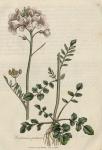030. Cardamine pratensis. Common ladies-smock, or, Cuckow-flower.

 Synonyma. Cardamine. Pharm. Lond.& Edin.
Synonyma. Cardamine. Pharm. Lond.& Edin.
Nasturtium pratense magno flore. Bauh. Pin. 104.
Nasturtium pratense majus seu Cardamine latifolia. Park. 825.
Iberis Fuchsii seu Nasturtium pratense sylvestre. J. B. 2. 889.
Cardamine. Gerard. Raii. Hist. Sp. 2. p. 814. Synop. 299.
Cardamine foliis pinnatis radicalibus subrotundis, caulinis linearibus. Hal. No. 473.
Cardamine pratensis. With. Bot. Arrang. 688. Relhan. Flor. Cant. 255. Curt. Flor. Lond.
α Floribus simplicibus.
β Floribus plenis, H. Kew.
(greek). Dioscor.
Class Tetradynamia. Ord. Siliquosa. L. Gen. Plant. 812.
Ess. Gen. Ch. Siliqua elastice dissidiens valvulis revolutis. Stigma integrum. Cal. subhians.
Spec. Char. C. foliis pinnatis: foliolis radicalibus subrotundis; caulinis lanceolatis.
The root is perennial, branched, and sends off many long round fibres; the italic is erect, round, smooth, sometimes branched towards the top, and rises about nine inches high: the leaves are pinnated, radical leaves frequently wanting, otherwise spreading in an orbicular shape, with roundish pinnae, which are dentated, or cut into several irregular unequal angles; the leaves upon the stalk are erect, and consist of four or five pair of pinnae, which are narrow, spear-shaped, concave, pointed, and the odd or terminal leafits are the largest; the flowers terminate the stem in a cluster or racemus, and stand upon smooth naked peduncles; the calyx is composed of four scaly leaves, which are oblong, obtuse, concave, deciduous, and alternately protuberant at the base; the corolla is cruciform, and of a purplish white colour; the petals are obversely veined, somewhat notched at the apex, and yellowish at the base; the filaments are six, four long and two short, inverted at the bottom with four nectareous glands; the antherae are final], oblong, and placed upright upon the summits of the filaments; there is no style; the germen is round, slender, about the length of the stamina, and becomes a long compressed pod of two valves, which, on opening, roll back in a spiral manner, and in the cells are contained many round seeds. It is common in meadows and moist pastures, producing its flowers in April and May. This plant has the same sensible qualities as water-cress, though in an inferior degree to it, and indeed to most of that class of plants, called by Dr. Cullen siliquosae, which comprehends both the orders of siliquosa and siliculosa of Linnaeus, and the cruciform of Tournefort. It is the flower of the Cardamine which has a place in the materia medica of the British Pharmacopoeias, upon the authority of Sir George Baker, who, in the year 1767, read a paper at the London College, recommending these flowers as an antispasmodic remedy, [We find no account of the use of these flowers but by Dale, who says of the plant, "Calida & acris est, & nasturtii pollet viribus. Flos in convulsionibus laudatur ex MSS. D. Tancred Robinson, M. D." Pharmacol, 204.] which has since been published in the Medical Transactions. [Medical Transactions, vol. 1. 442.] In this account Sir George relates five cases [Viz. two of chorea sancti Viti, one of spasmodic asthma, an hemiplegia accompanied with convulsionson the palsied side, and a case of remarkable spasmodic affections of the lower limbs; the two first were cured in less than a month; the two second were also happily removed: but in the last case the patient had experienced some relief from the flor. card, when she was seized with a fever which proved fatal. See l. c.] wherein the flores cardamines were successfully used; and in a P. S. to the second edition, he says, "Since the first edition of this volume, I have seen several instances of the good effects of flores cardamines in convulsive disorders." In Epilepsy, however, this remedy has been generally found unsuccessful. Greeding, who tried it in a great number of cases, and in large doses, experienced but one instance of its good effects. [Ludwig. Advers. Medico-pract. Vol. 3. P. 3. p. 564.] The dose of the powdered flowers is from half a dram to two drams.

